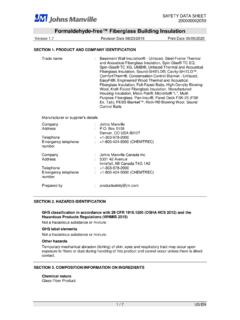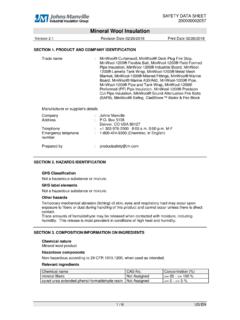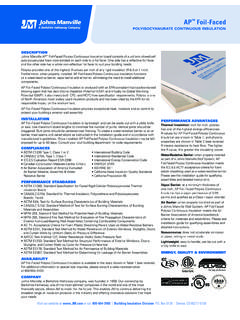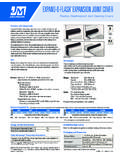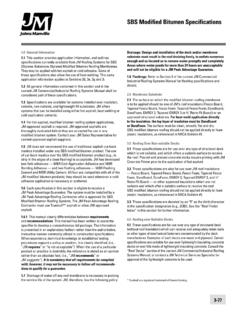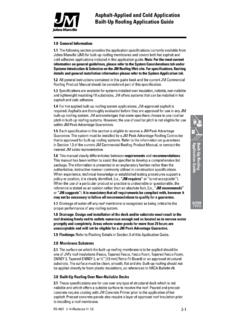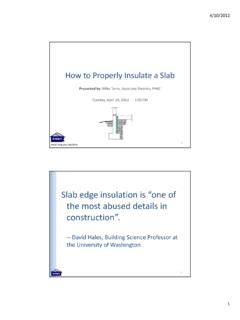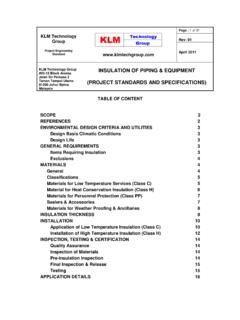Transcription of TECHNICAL DATA SHEET - Insulation Systems, Commercial ...
1 DESCRIPTIONJM Aluminum Jacketing is the premier protective outer surface for mechanical Insulation systems including pipe, vessels, and equipment. It protects the Insulation and underlying pipe/vessel from physical damage, UV exposure, corrosive atmospheres, and Aluminum jacketing (also called cladding) is available in smooth, stucco embossed, and 3/16 corrugated(cross-crimped) finishes. For larger surfaces, box-rib and deep corrugated sheets are also Aluminum Jacketing has a bare outer surface and comes standard with a 3-mil thick polyfilm moisture barrier heat-laminated to the interior surface to help prevent corrosion of the jacketing and the underlying metal pipe, vessel, or pure aluminum is relatively soft and less suited for use in this application.
2 Its strength can be greatly improved by alloying with small percentages of one or more other elements such as manganese, silicon, copper, zinc, and magnesium. Additional strength can be achieved by cold working. JM carefully screens all potential aluminum coil suppliers to assure our products have the highest quality, are corrosion resistant, and comply with all relevant Aluminum Jacketing is typically manufactured using alloys 3105 or 3003 which have very similar composition and performance and are considered interchangeable for use as Insulation jacketing. JM reserves the right to ship whichever alloy is in stock at the time of order placement.
3 One of these two specific alloys or an alternative alloy can be specified by purchaser at time of order placement but this may affect minimum quantity, lead-time, and price. Composition Differences in Aluminum Alloys (%)AlloyCuMnMgZn3105 TO STANDARDSAll bare and polyfilm lined JM Aluminum Jacketing complies with the requirements of ASTM C1729 (Aluminum Jacketing Material Standard) which includes the strength and chemical composition requirements for compliance to ASTM B209 (Aluminum Alloy Standard).JM ALUMINUM ROLL AND SHEET ALUMINUM METAL JACKETING/CLADDINGRECOMMENDED USESA luminum Jacketing is recommended for use in all of the following Insulation system applications: Standard outdoor use on all pipe, vertical tank Insulation systems up to 8 ft outer diameter, and all horizontal tanks Indoor Insulation system applications up to 8 ft outer diameter where increased damage resistance is desiredLIMITATIONS ON USEA luminum Jacketing is not appropriate for the following applications.
4 For vertical tank Insulation system applications where the outer diameter is larger than 8 ft, JM deep corrugated aluminum sheets should be used Where increased emissivity is desired, painted aluminum jacketing should be considered For applications where a maximum resistance to fire is required, stainless steel jacketing should be used For applications where additional resistance to corrosion from the external environment is required, JM painted aluminum jacketing may be used. Where maximum resistance to corrosion is required, JM stainless steel jacketing (T304 or T316) should be MOISTURE BARRIERP olyfilm Moisture Barrier (PFMB) is an engineered three layer coextruded film of polyethylene and Surlyn* polymers with a total film thickness of 3 mils (76 m) that is heat laminated in the factory to the interior surface of aluminum jacketing.
5 JM recommends the use of PFMB on all aluminum jacketing to help prevent pitting, crevice, and galvanic corrosion of the interior surface of the metal jacketing and the insulated pipe, tank, or to its superior performance characteristics, PFMB replaces the old moisture barrier technology of 1 to 3 mil thick polykraftTECHNICAL DATA SHEET *Surlyn is a trademark of DuPontFormerly Pabco/Childers Metal05/11/20 (Replaces ACCS-05/07/20)Formerly Pabco/Childers MetalsTechnical specifications as shown in this literature are intended to be used as general guidelines only. Please refer to the Safety Data SHEET and product label prior to using this product.
6 The physical and chemical properties of the product listed herein represent typical, average values obtained in accordance with accepted test methods and are subject to normal manufacturing variations. They are supplied as a TECHNICAL service and are subject to change without notice. Any references to numerical flame spread or smoke developed ratings are not intended to reflect hazards presented by these or any other materials under actual fire conditions. Check with the Regional Sales Office nearest you for current information. All Johns Manville products are sold subject to Johns Manville s standard Terms and Conditions, which includes a Limited Warranty and Limitation of Remedy.
7 For a copy of the Johns Manville standard Terms and Conditions or for information on other Johns Manville thermal Insulation and systems, visit or call (800) (Replaces ACCS-05/07/2020)717 17th St. Denver, CO 80202 (800) 866-3234 2020 Johns Manville All Rights ReservedRECOMMENDED THICKNESSJM recommends that the thickness of aluminum jacketing used vary based on the outer diameter of the Insulation system per the requirements of ASTM C1729. This recommended thickness is shown in the table Aluminum Jacketing has an outer surface emittance per ASTM C1371 and specified by ASTM C1729 of: Bare aluminum (oxidized in service ) = FINISHESEach of the three surface finishes available for JM Aluminum Jacketing (smooth, stucco embossed, and 3/16 corrugated has applications where it is recommended.)
8 All of these can be supplied with a painted exterior. For more information on this, consult the JM data SHEET on painted aluminum (Plain Mill) FinishThis is a very popular finish and is the default for the many end-users/specifiers who prefer the clean look of this finish. This finish sheds rain water the best. However, this smooth surface readily shows damage such as from hail or other physical abuse. It is also shows the dirt more than the other finishes due to its smoothness. Lastly, it is highly reflective of sunlight and when located near roadways, some specifiers see this reflection as a possible safety ALUMINUM ROLL AND SHEET ALUMINUM METAL JACKETING/CLADDINGS tucco Embossed Finish This is another popular finish used for aluminum jacketing.
9 The stucco-like surface texture hides small imperfections and scratches caused by physical damage during or after installation. This finish also reduces reflectivity while still looking very professional. Lastly, the use of stucco embossed finish provides a small increase to the rigidity and strength of the aluminum Corrugated (Cross-Crimped) FinishThis finish consists of parallel grooves or crimps about 3/16 apart running in the length direction of the pipe. This finish also hides small damage and scratches to the jacketing and reduces sunlight reflection. In addition, the nature of this finish gives the aluminum jacket more ability to expand and contract to adapt to Insulation movement caused by pipe or ambient temperature changes.
10 Lastly, the rigidity and strength of 3/16 corrugated finish is substantially increased making it ideal for use as jacketing on large diameter pipe and vessels up to 8 ft diameter. This finish is available in a maximum thickness of Aluminum Jacketing with a 3 mil polysurlyn moisture barrier has been tested for flammability using the industry standard ASTM E84 test method. The results were: ASTM E84 Flame Spread Index: 0 ASTM E84 Smoke Developed Index: 5(Tested with exterior metal surface exposed to the flame) TECHNICAL DATA SHEETO uter InsulationDiameter (in)Minimum Aluminum Jacket Thickness, inches (mm)Rigid InsulationNon-Rigid Insulation ( ) ( )Over 8 thru ( ) ( )Over 11 thru ( ) ( )Over 24 thru ( ) ( )> ( ) ( )
